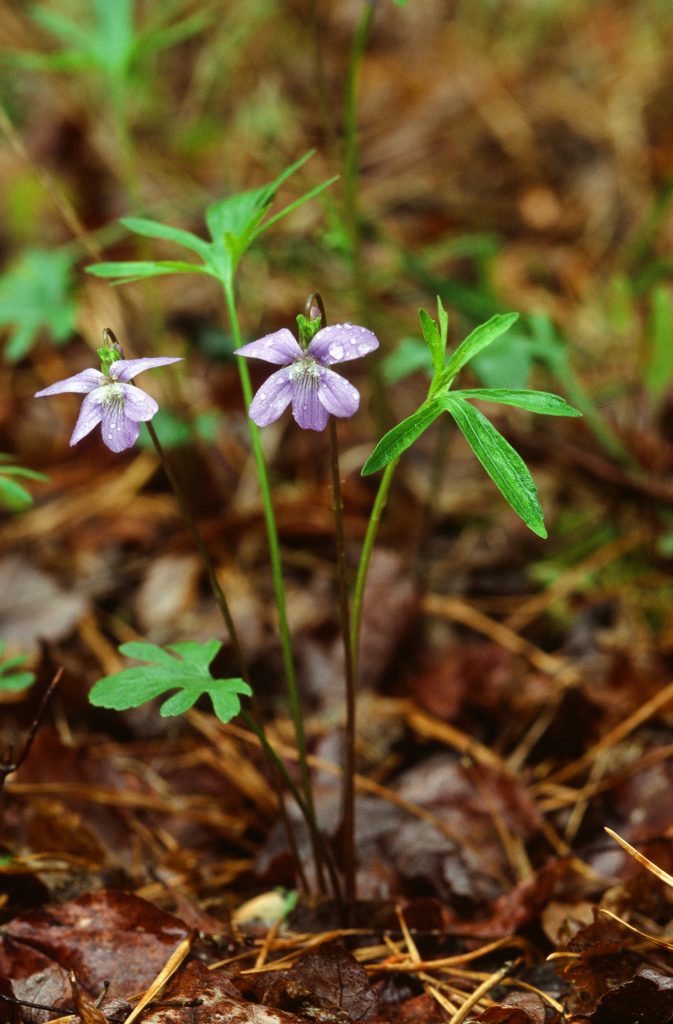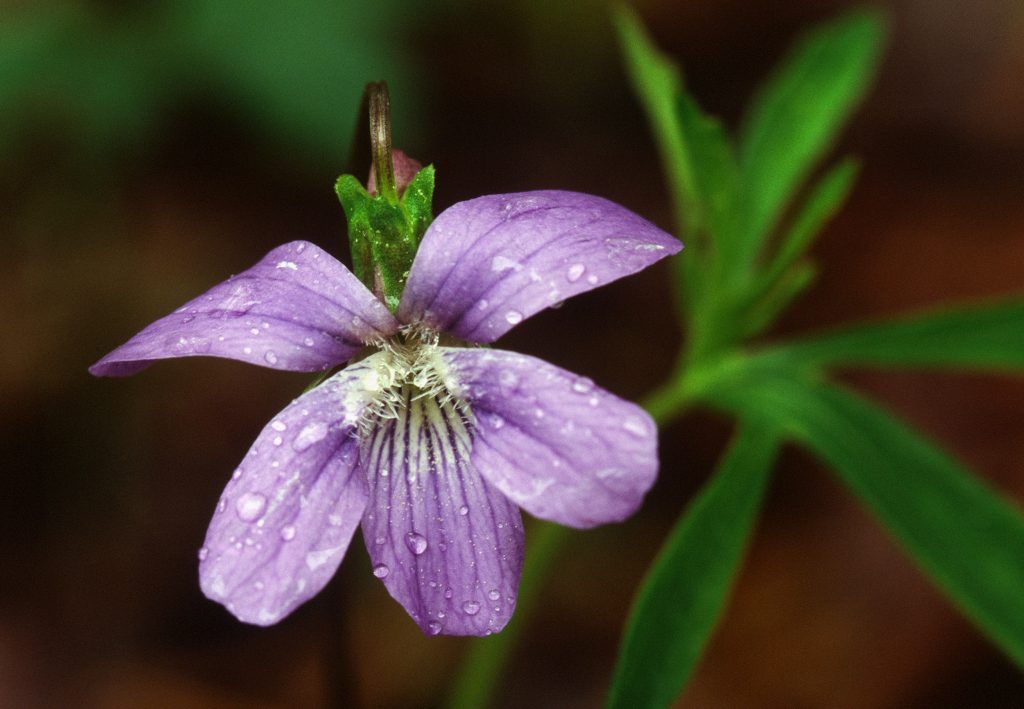Viola brittoniana Pollard
Kim’s unedited notes. Illustrations: 2 photographs of Viola brittoniana and 2 drawings.
Bot. Gaz. 26: 332. 1898


TM: Section Nosphinium, subsect. Boreali-Americanae [NEW classification, 2010].
http://plants.usda.gov Plant Images:
Distribution by State: CT, DE, MA, NC, NJ, NY, PA, SC, VA.
East coast states from North Carolina to Maine, including Pennsylvania, but excluding VT, NH, RI.
V. brittoniana is treated as a subspecies of V. pedatifida (Landon McKinney, 1992; McKinney & Russell, 2002), but as a full species by Harvey in the plants of Pennsylvania, second edition (2007)
V. pedatifida G. Don ssp. brittoniana (Pollard) McKinney.
Ezra Brainerd (1904) included V. brittoniana under Viola septemloba saying he could not see them as being specifically distinct. Confined to New England coastal regions.
V. pedatifida G. Don ssp. brittoniana (Pollard) McKinney.
NY Botanic Gardens: Lectotype: coll. 8 June 1888 by N.L. Britton, Richmond County, New Dorp, Staten Island, Salt meadows. Specimen ID # 97513. (syn. Viola atlantica Britton).
Named for Nathaniel Lord Britton, 1859-1934, First director (founder?) of the New York
Botanical Garden. Also Britton & Brown.
BRITTON, Nathaniel Lord, botanist, born on Staten Island, New York, 15 January, 1858. He was graduated at the Columbia College School of Mines in 1879 with the degree of E. M., and in 1881 received the degree of Ph. D. in 1881 for his thesis A Preliminary Catalogue of the Flora of New Jersey. In 1879 he became assistant in the department of geology and paleontology, and lectured on botany in the school of mines. For some years he was botanist and assistant geologist to the New Jersey geological survey, spending his summers in fieldwork. The “Bulletin of the Torrey Botanical Club” was under his editorial supervision, and, besides scattered papers on technicalities in scientific journals, he published “Catalogue of the Flora of Richmond County (Staten Island), New York” (1879); “The Geology of Staten Island” (1880); and “Catalogue of the Flora of New Jersey (1882).
Peterson Field Guide: The difference between Viola brittoniana species and V. pedatifida is that the latter is not coastal, flowers are paler, leaf lobes are very narrow. Seeds?

The painted illustration of E. Brainerd’s specimen of Viola septemloba from near Sommerville, SC shown in both Brainerd’s book and his daughter’s book shows a leaf that is exactly the same as my drawing for Viola brittoniana from New Jersey!! [All references say that V. septemloba is not found north of southern Virginia, so I can’t have muddled the two species.] I think that these two species are the same but must try to compare seeds, the only remaining characteristic still said to be different, both in size, weight and colour (see V. septemloba file).
Mature seeds very pale brown! 1.5-1.6 x 1.0 mm. Elaiosome absolutely clear or colourless, small. Collected in New Jersey, 5 yds past 2-mile post on Clarke’s Landing Road, on RHS. [V. pedatifida seeds are larger, 2.2 x 1.1 mm; pale to dark brown. V. septemloba seeds are dark brown].
Russell (1955) mentioned two hybrids of Boreali-Americanae x Primulifoliae — V. brittoniana x lanceolata and V. cucullata x primulifolia?
Harvey Ballard in The Plants of Pennsylvania:
Stemless; rhizome ascending, 4-6 mm thick; leaves deeply twice-ternately dissected, blade outline ovate, rounded at the tip and cordate at the base, glabrous [NO! not under the microscope!] ; segment margins subentire to remotely serrate; corolla purple; spurred petals bearded within with long thread-like hairs; capsules green, on erect peduncles; seeds brown; very rare [in PA] in moist sandy woods and flats; extreme SE; flr. Apr-May; [V. pedatifida G.Don ssp. brittoniana (Pollard) McKinney of Rhoads and Klein, 1993]. Interesting that Harvey has changed this back to species rank from the treatment of McKinney!! and he says that seeds are brown, cf. Viola Brainerd Baird who says that seeds are buff. [Collected in NJ, they are very pale brown or buff]. She says V. septemloba’s seeds are dark brown. Looking at the very short pubescence on the leaf margins and leaf upper surface veins, it is identical in distribution, size and shape for both species. I think that there is no justification in separating Viola septemloba from Viola brittoniana, and the former species date of publication takes precedence. [Now I don’t agree with this statement].
limited to the eastern coastal regions
Distribution: Found along the Atlantic coast from New England to South Carolina.
Habitat: Coast habitats with sandy or boggy soils.
Smithsonian herbarium has isotype:
Viola brittoniana Pollard, C.L., Bot. Gaz. 26 :332. 1898 – Isolectotype (Violaceae)
COLLECTION: Britton, N.L. s.n., 21 May 1893. USA. New York. Staten I.
COLLECTION REMARKS: Also a type of Viola atlantica Britton (non Pomel, 1874) in Bull. Torrey Bot. Club 24:92. 1897.
LECTOTYPIFIED BY: McKinney, L.E., Sida Bot. Misc. 7. 1992
CURRENT PLACEMENT: Viola pedatifida subsp. brittoniana (Pollard) McKinney (Violaceae)
VERIFICATION: Specimen compared to the original publication.
US SHEET NO.: 00007346 BAR CODE: 00479254
www.dickinson.edu/prorg/pabs/vascular_plants.htm V.brittoniana listed as threatened in PA.
Normal H. Russell, Violets (Viola) of Central and Eastern United States: An Introductory Survey, SIDA 2 (1): 1-113. 1965, Lloyd H. Shinners:
This pretty little violet [V. septemloba] may produce one or two entire leaves in early spring, but the typical leaf from is pedate, with 7 to 9 slightly oblanceolate lobes. It grows in moist places in pine forests in the southeast. It rarely forms dense clones or mats; instead the plants occur singly, often widely separated from each other.
In the discussion of Viola pedata, its similarities to that species and to V. brittoniana, which replaces it in the northeast, were mentioned. [=Viola pedata has long been considered to be very distinct from other violets and to have no close relatives. However, on morphological grounds, there are two other violets which resemble it: V. septemloba and V. brittoniana. Their similarities and ranges suggest that they form a small species complex, perhaps derived from a single ancestral form. I don’t agree with this. I see V. septemloba and V. brittoniana as being much more like V. pedatifida.] I have seen some specimens with leaves almost identical to those of V. pedata. Both Gray and Brainerd (Brainerd, 1921) considered it to be most closely related to V. palmata. It does not appear so to me. [Kim, 2008: I think V. septemloba and V. brittoniana are very similar, but flower not similar to true V. pedatifida. Also, I have found hybrids of V. pedata with V. sororia that are similar but not the same as the two former species]. In the southeast, it is most easily confused with V. esculenta, and can sometimes be distinguished only with difficulty. I have found the shape of the leaf lobes the best feature. V. esculenta has broader, more obovate lobes, more similar to those of V. triloba var. triloba.
V. septemloba LeConte (1826), V. brittoniana Pollard (1898).
TM, 19 Jul 2010: Did you notice that Russell (1955; The taxonomy of the North American acaulescent white violets) mentioned two hybrids of Boreali-Americanae x Primulifoliae — V. brittoniana x lanceolata and V. cucullata x primulifolia?
Specimen collected by Janet and John Gyer at Portsmouth, New Hampshire. Pressed leaf is unfortunately folded in many places, ends of divisions are mostly damaged but two are intact and are pointed. Under side of leaf is paler. No obvious gland at tips of segments and can’t see if there are any in axils of divisions because they are covered with a localized small patch of hairs. Pubescence on lower veins, lamina and more concentrated at margin of leaf. Same for top surface but hairs much shorter about 1/3 length and more sparce. Very stout petiole, broken so can’t see length, specimen collected mid-May so not a late summer leaf. But it is large. Hairs around margin. see imported illustration of leaf margin, hairs in two directions.
‘Salt meadows, alluvial woods, damp, thickets, infrequent’ Landon McKinney.
